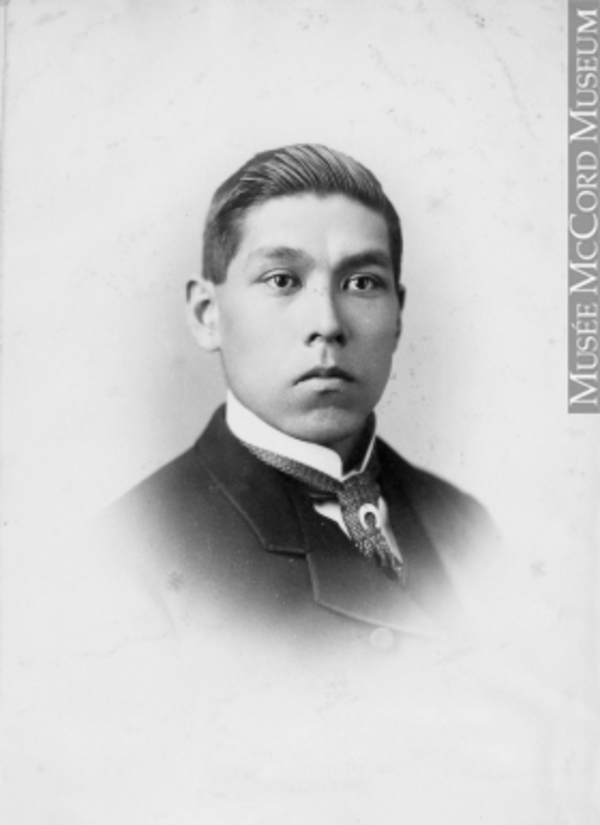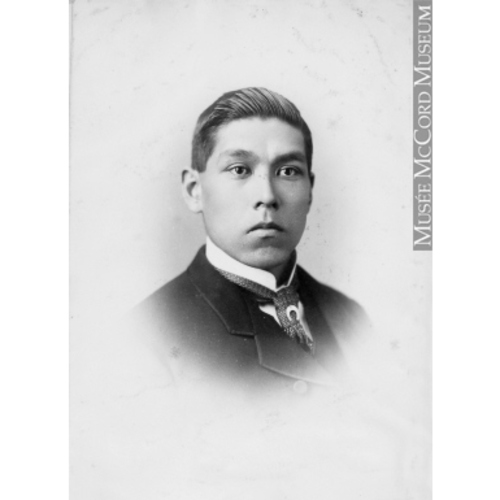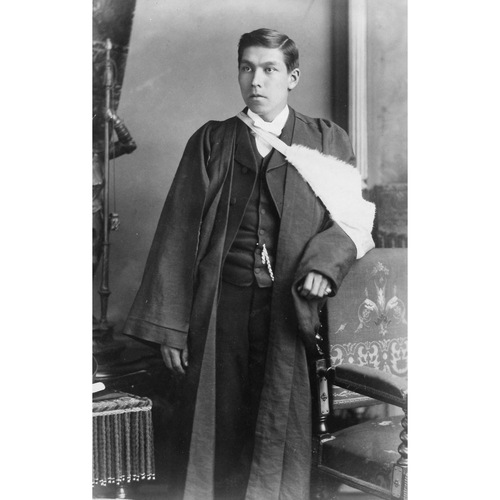
Source: Link
GREEN, THOMAS DANIEL, member of the Six Nations of the Grand River, engineer, surveyor, and sportsman; b. 21 Dec. 1857 near Brantford, Upper Canada, son of Daniel Green and Mary Crawford; m. 11 Sept. 1889 Mary (Minnie) Catherine Plumb (d. 26 May 1935) in Prescott, Ont.; they had no children; d. 29 Nov. 1935 in Rocky Mountain House, Alta.
Thomas Daniel Green’s Six Nations ancestors arrived in southern Upper Canada in the mid 1780s to join Joseph Brant [Thayendanegea*] on the Haldimand grant along the Grand River. During the War of 1812 Thomas’s grandfather Chief Peter Green fought on the British side at the battle of Beaver Dams [see James FitzGibbon*]. The Green family embraced European-style agriculture and established a farm northeast of Brantford. Peter Green was a member of the Six Nations Council when the confederacy’s territory was consolidated in 1841 into the Six Nations Reserve. The Greens belonged to the Church of England and attended the Mohawk chapel, where the first two generations in Canada are buried in a family plot.
Thomas, the youngest of six children, was only seven when his father died in 1865. His mother continued to operate the Green farm, which was outside the reserve. Very close to the Green home stood Howell’s School, where Thomas attended primary classes. In January 1873, at the age of 15, the gifted youth entered the Mohawk Institute in Brantford, which had been founded by Robert Lugger* and was run by the New England Company. His success after two years at this Indian residential school – where he acted, when available, as a monitor, or teacher’s assistant – led Robert Ashton, the school superintendent, to recommend that Thomas write the entrance examination for the Brantford Collegiate Institute. In 1875 he obtained the highest grade of all 41 applicants from Brant County.
Thomas did well at the collegiate. At the end of his first year, he won prizes in his class in English, Latin, mathematics, and general proficiency. Impressed by his progress, Ashton made arrangements for him to board at the Mohawk Institute for two more years while attending the collegiate. James Mills*, principal of the collegiate, described Green as “a young man of good ability, above the average; of thoughtful, studious habits; and of untiring perseverance.”
After completing his secondary education in 1878, Green entered McGill College in Montreal, where he began the course in civil engineering. The New England Company provided an annual grant of $50 for his studies, and the Six Nations Council matched this amount. At the end of his first term, Thomas won prizes in mathematics and chemistry. Pleased by his excellent results, the council raised its annual gift to $100. Green graduated with honours in 1882. He passed the final examinations to become a dominion land surveyor in 1884. He would soon be made an Ontario land surveyor, and later he would become an Alberta land surveyor.
Lawrence Vankoughnet, deputy superintendent general of Indian affairs, looked upon the new McGill graduate as a role model for other First Nations students. In 1884, when Green was working temporarily as a draftsman under Édouard Deville*, the chief inspector of surveys for the Department of the Interior, Vankoughnet recommended the “deserving young man” for a position with the Canadian Pacific Railway. Unfortunately, Green did not find a job there. To what degree racial discrimination played a role is unknown. Given his excellent academic record, his difficulty in securing full-time work is puzzling. The young engineer failed as well to obtain a permanent civil-service job. Even the support of Prime Minister Sir John A. Macdonald* was unavailing. Twice Macdonald endorsed the recent McGill graduate, writing in 1885 and again in 1886, that he should be “encouraged.”
In the mid 1880s Green worked from spring to fall surveying reserves in Manitoba and the North-West Territories. Apparently, he did his utmost to secure the maximum amount of land for the First Nations. Writing on 9 March 1885 to Macdonald, who was also superintendent general of Indian affairs, he explained that he had expanded the size of the reserve allotments “in order to make allowances for marshes & other wastelands, and thus acquire as near as possible the required amount of good land.” During the spring of 1885 Green was in the northwest and saw first-hand the disruption of the resistance led by Louis Riel*.
From Regina on 8 March 1886, Green wrote to Macdonald offering some sound advice. Sending in the army was not the way to win over the Indigenous peoples of the plains, he observed. Instead, “a dozen, or so, of the principal chiefs of the different tribes of the N.W. Indians” should be taken to Ottawa to meet with the prime minister. “Good, honest and reliable interpreters” should be hired to accompany them. The visitors should be shown “the principal sights & cities of Ontario & Quebec” and “the most prosperous Indian Reserves of these provinces.” In short, Green wrote, “Let them see how their Indian brethren are prospering in those provinces; let them understand that the Indian can subsist like the whiteman where there is no game; and let them understand that the government do not wish to exterminate them.”
Green had loved hockey as a student at McGill. During winters in Ottawa he played with the recently organized Ottawa Hockey Club, as did Albert Peter Low*, who had graduated in engineering with him. In 1886 Green was elected captain of its team. He had many friends in the city. The previous year he had been invited to join the Civil Service Lodge No.148 of the masonic order; he was also active in the Association of Dominion Land Surveyors. An excellent speaker, he had, one obituary would report, “a splendid command of the English language.” The members of the Ottawa Hockey Club chose their capable captain to represent them at the founding meeting of the Amateur Hockey Association of Canada. The group assembled in Montreal and elected Green as president of the game’s first multi-club association, the organization to which the National Hockey League traces its origins. Green also played in, and occasionally refereed, hockey matches between government departments in Ottawa. He curled as well, with the Rideau Curling Club and the Department of the Interior rink.
Throughout the late 1880s a full-time job with the federal government still eluded Green, but in 1891 he finally achieved a permanent position as a draftsman in the technical branch of the Department of Indian Affairs, the only ministry that would hire him. He encountered discrimination there. Although he had qualified and was working as a surveyor, he was paid as a third-class clerk, receiving significantly less, for the same work, than did those of his classmates who had joined the department. He resigned in 1893. That year he obtained part-time employment in the Department of the Interior and was for the first time paid at surveyor’s wages, working in the northern section of the District of Alberta. In 1894 he accompanied John Stoughton Dennis, chief inspector of surveys, on a new venture: an assessment of the distribution of water in the district for irrigation purposes. After continuing with this assignment in 1895, he returned in December to the Department of Indian Affairs, as assistant surveyor. Much of his work was in the Yukon, where he dealt with mining claims. Writing from Dawson City at the height of the gold rush in 1899, he again resigned. He explained that he did so because he was debarred as a government employee from staking or purchasing claims, and from securing a miner’s licence.
Green had a successful career in the Yukon. The engineer and surveyor joined up with geologist Joseph Burr Tyrrell* to form a consulting firm, Tyrrell and Green, mining engineers and surveyors. It was an ideal association since each partner had a different range of knowledge and skills. Green and his wife, Mary, a non-Indigenous woman, had an attractive home in Dawson City. Still an avid sportsman, Green, at 45 years of age, participated in 1903 in an exhibition boxing match. He was knocked out in the second round. After their departure from the Yukon in 1907, Mary and Thomas went on a six-month tour of Europe.
The Greens then settled in Rocky Mountain House in Alberta. Thomas had completed the subdivision of the site. In 1910 they homesteaded three miles south of the village. Thomas continued to do surveying work and joined the local masonic lodge. The couple moved to Edmonton in 1934 for the sake of Mary’s health. Half a year after her death there in 1935, he died on a visit to Rocky Mountain House. “A highly respected gentleman, who from his wide experiences proved a most interesting companion at any time, the familiar figure of T. D. Green will be greatly missed,” commented the local paper, the Mountaineer. Green’s funeral was held in Edmonton with full masonic honours.
Thomas Daniel Green’s report on his surveying activities in 1893 appears in the annual report of the Dept. of the Interior in Can., Parl., Sessional papers, 1894.
AO, RG 80-5-0-169, no.006773. LAC, MG26-A, vol.290, L. Vankoughnet to Sir John A. Macdonald (central.bac-lac.gc.ca/.redirect?app=fonandcol&id=530556&lang=eng, pp.132810–13); vol.424, T. D. Green to Sir John A. Macdonald (central.bac-lac.gc.ca/.redirect?app=fonandcol&id=478556&lang=eng, pp.206289–91); vol.432, T. D. Green to Sir John A. Macdonald (central.bac-lac.gc.ca/.redirect?app=fonandcol&id=478558&lang=eng, pp.212907–8); RG10, vol.2068, file 10308, James Mills to the Six Nations Council, 5 April 1878, and J. T. Gilkinson to superintendent general of Indian Affairs, 25 Sept. 1878 (both letters can be accessed at central.bac-lac.gc.ca/.redirect?app=fonandcol&id=2062076&lang=eng, pp.13, 15); vol.2093, file 16030, J. T. Gilkinson to superintendent general of Indian Affairs, 22 Dec. 1879 (central.bac-lac.gc.ca/.redirect?app=fonandcol&id=2067345&lang=eng, p.9); vol.2520, file 106926, memorandum, 15 July 1891 (central.bac-lac.gc.ca/.redirect?app=fonandcol&id=2062815&lang=eng, p.9); vol.3685, file 13033, T. D. Green to superintendent of Indian affairs, 9 March 1885 (central.bac-lac.gc.ca/.redirect?app=fonandcol&id=2058358&lang=eng, pp.16–24); RG15-DII-1, vol.291, file 57629, L. Vankoughnet to Sir John A. Macdonald, 8 July 1885 and A. M. Burgess to E. Deville, 4 Aug. 1885 (heritage.canadiana.ca/view/oocihm.lac_reel_t12558, images 158–60). MUA, RG 7, Students’ directory, 1878–82. Private arch., Floyd Doctor (Brantford, Ont.), Green family, geneal. information and photographs. “Knockout in two rounds,” Yukon World (Dawson City, Y.T.), 11 Feb. 1903. Ruth Lefler, “A man of firsts,” Brantford Expositor, 27 Jan. 2013. Mountaineer (Rocky Mountain House, Alta), 29 May, 4 Dec. 1935. Ottawa Citizen, 8, 10 Dec. 1886. Ottawa Evening Journal, 10 Jan., 13 Feb. 1895; 30 Jan. 1896; 28 Jan., 22 Feb., 20 Dec. 1897; 17 Dec. 1898; 1 March 1907. Winnipeg Tribune, 19 Feb. 1892. Assoc. of Ont. Land Surveyors, Annual report (Toronto), 1936: 124–25. Civil Service Lodge No.148, “Renowned members”: www.csl148.ca/lodge/renownedmembers (consulted 25 July 2018). Alex Inglis, Northern vagabond: the life and career of J. B. Tyrrell (Toronto, 1978). Paul Kitchen, Win, tie, or wrangle: the inside story of the old Ottawa Senators, 1883–1935 (Manotick, Ont., 2008). Judy Larmour, Laying down the lines: a history of land surveying in Alberta (Calgary, 2005). McGill Univ., Annual calendar (Montreal), 1879/80: 155; 1882: 110, 124. Six years’ summary of the proceedings of the New England Company … (London, 1879). The valley of the Six Nations: a collection of documents on the Indian lands of the Grand River, ed. C. M. Johnston (Toronto, 1964), 189–92, 203–4.
Cite This Article
Donald B. Smith and Floyd Doctor, “GREEN, THOMAS DANIEL,” in Dictionary of Canadian Biography, vol. 16, University of Toronto/Université Laval, 2003–, accessed January 19, 2026, https://www.biographi.ca/en/bio/green_thomas_green_16E.html.
The citation above shows the format for footnotes and endnotes according to the Chicago manual of style (16th edition). Information to be used in other citation formats:
| Permalink: | https://www.biographi.ca/en/bio/green_thomas_green_16E.html |
| Author of Article: | Donald B. Smith and Floyd Doctor |
| Title of Article: | GREEN, THOMAS DANIEL |
| Publication Name: | Dictionary of Canadian Biography, vol. 16 |
| Publisher: | University of Toronto/Université Laval |
| Year of publication: | 2023 |
| Year of revision: | 2023 |
| Access Date: | January 19, 2026 |




